Unveiling the Essence of Vulnerability Assessment and Penetration Testing

Strong 8k brings an ultra-HD IPTV experience to your living room and your pocket.
In an era where cybersecurity breaches are becoming increasingly prevalent, organizations must fortify their digital defenses to safeguard sensitive data and uphold the trust of their stakeholders. Among the array of cybersecurity measures available, Vulnerability Assessment and Penetration Testing stand out as indispensable tools in identifying and remedying potential vulnerabilities within an organization's IT infrastructure.
Understanding Vulnerability Assessment (VA)
Vulnerability Assessment involves a systematic examination of an organization's network, systems, and applications to identify security weaknesses that could be exploited by cyber attackers. The process typically includes:
1. Asset Identification: Identifying and cataloging all assets, including hardware, software, and data repositories, within the organization's IT environment.
2. Vulnerability Scanning: Using automated tools to scan the network and systems for known vulnerabilities, such as outdated software versions, misconfigurations, or weak encryption protocols.
3. Risk Prioritization: Assessing the severity of identified vulnerabilities based on factors such as their potential impact on the organization's operations and the likelihood of exploitation by attackers.
4. Remediation Recommendations: Providing recommendations and action plans to address identified vulnerabilities, including patching software, updating configurations, and implementing security controls.
Penetration Testing (PT): Going Beyond Identification
While Vulnerability Assessment focuses on identifying vulnerabilities, Penetration Testing takes a step further by simulating real-world cyber attacks to assess the effectiveness of existing security measures. The process involves:
1. Planning and Reconnaissance: Understanding the organization's IT infrastructure, identifying potential entry points, and gathering information about target systems.
2. Attack Simulation: Attempting to exploit identified vulnerabilities using various techniques, such as network scanning, social engineering, and malware deployment.
3. Privilege Escalation: Once access is gained, attempting to escalate privileges to gain deeper access to sensitive systems and data.
4. Reporting and Remediation: Documenting the findings, including successful exploits and areas of weakness, and providing recommendations for improving security posture.
The Benefits of VA and PT
1. Risk Mitigation: By identifying and addressing vulnerabilities proactively, Vulnerability Assessment and Penetration Testing help reduce the likelihood of successful cyber attacks, minimizing potential damage to the organization.
2. Compliance Requirements: Many regulatory standards and industry frameworks, such as GDPR and PCI DSS, mandate regular VA and PT assessments to ensure compliance with data protection requirements.
3. Enhanced Security Awareness: VA and PT provide valuable insights into the organization's security posture, raising awareness among stakeholders about potential risks and the importance of cybersecurity measures.
4. Cost Savings: Identifying and remediating vulnerabilities before they are exploited can save organizations significant costs associated with data breaches, legal liabilities, and reputational damage.
Conclusion
In today's hyper-connected digital landscape, cybersecurity is not just a priority but a necessity for organizations of all sizes and industries. Vulnerability Assessment and Penetration Testing play vital roles in strengthening cyber defenses, identifying weaknesses, and mitigating risks. By investing in these proactive measures, organizations can stay one step ahead of cyber threats, safeguarding their assets, reputation, and trust of stakeholders in an increasingly volatile digital world.
In an increasingly interconnected and digitally driven world, cybersecurity has emerged as a critical priority for organizations across all sectors. Vulnerability Assessment and Penetration Testing serve as vital components of a comprehensive cybersecurity strategy, enabling organizations to proactively identify and address potential vulnerabilities before they are exploited by cyber adversaries. By embracing these proactive measures, organizations can bolster their defenses, safeguard their assets, and maintain the trust and confidence of their stakeholders in an ever-evolving threat landscape.
Note: IndiBlogHub features both user-submitted and editorial content. We do not verify third-party contributions. Read our Disclaimer and Privacy Policyfor details.





